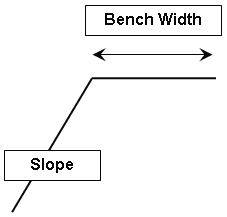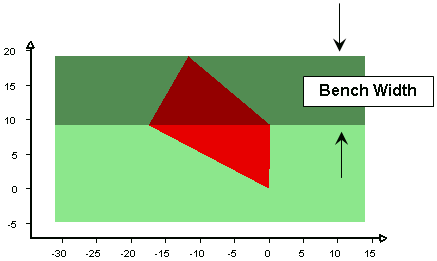Slope Bench Width
The Bench Width option can be used to limit or scale the wedge size according to bench width (i.e. the width of the Upper Face slope plane). The Bench Width is always measured as the HORIZONTAL distance from the crest of the slope, even if the Upper Face slope has a non-zero dip, as shown in the following figures.


The Bench Width is an optional input parameter, which is enabled by selecting the Bench Width check box in the Input Data dialog.
- If the Bench Width option is NOT selected, then there is no restriction on the width of the Upper Face slope plane (i.e. the dimension of the wedge on the Upper Face). The wedge size will be determined by the Slope Height or other scaling parameters which may be in effect.
- If the Bench Width option is selected, then the wedge size will be limited by the user-defined Bench Width, in addition to the Slope Height and other scaling parameters.
For example, in the model below, a Bench Width of 10 meters has been specified, and the wedge size has been scaled accordingly.
Bench Width = 10 meters, top view of slope

Notes:
- Remember that the Bench Width is a limiting value. In order to have an effect on the analysis, the Bench Width must define a SMALLER wedge than would be defined by the Slope Height or other scaling parameters.
- The Bench Width is always measured perpendicular to the crest of the slope. This is relevant if the crest is not horizontal (i.e. slope face and upper face have different dip direction).
- If a Tension Crack is defined, the Bench Width cannot define a SMALLER wedge than is defined by the Trace Length used for the Tension Crack location (if the Tension Crack location is user-defined).
- If the Bench Width is not specified, it is possible to generate wedges which have a very long dimension in the direction of the Upper Face slope. This can result in wedges which have unrealistic dimensions. In this case, it may be necessary to use the Bench Width option to limit the wedge size.
Bench Width in a Probabilistic or Combination Analysis
A user-defined Bench Width is recommended in a Probabilistic Analysis, to ensure that all wedges generated by the statistical sampling of joint orientations will be limited in size by the Bench Width. If a Bench Width is not defined, then the Probabilistic Analysis may generate unrealistically long wedges in the direction of the Upper Face slope.
For the same reasons, the Bench Width option is also recommended for a Combination Analysis.
Bench Width as a Display Option
When you specify a Bench Width, the SWedge model is drawn using the actual value of Bench Width. Therefore, you can use the Bench Width option to display the actual bench width or adjust the appearance of the model for screen capture purposes.
If the Bench Width is NOT specified, then the apparent (graphical) bench width is automatically calculated by SWedge based on the current wedge size.